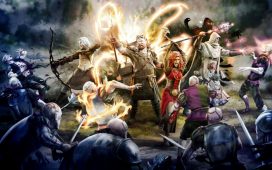‘Before you embark on a journey of revenge, dig two graves.” So goes the saying popularly (if spuriously) attributed to Confucius – a proverbial truth that The Last of Us Part II explores, unflinchingly and sometimes gruesomely, for 30 hours. It is difficult to explain how exactly it does this without robbing players of the chance to experience it for themselves, but I will say this: no video game has ever gone to these lengths to humanise the enemy, or to interrogate the violence that it asks the player to perform.
We play as Ellie, a 19-year-old born a few years after a fungal illness devastated human civilisation, turning the afflicted into shambling, deformed husks and the world’s cities into overgrown relics. Since the events of The Last of Us (2013), she has been living in a stable community of survivors, making friends, learning the guitar, kissing girls at dances. But a traumatic event drives her to leave the relative safety of Jackson on a revenge mission that takes her to the remains of Seattle.
The city has been ravaged first by the military, then by the infected, and finally by nature. Vegetation grows through the cars rooted to the highway and rusting skyscrapers preside over ominously empty streets. Abandoned storefronts and apartment buildings might hide notes from doomed former residents, scrap with which to fix up Ellie’s weapons or craft improvised explosives and health kits – or dormant infected ready to tear her to bits. Before long, she comes into contact with the remaining human residents of the city: the remnants of a well-equipped militia and the unsettling followers of a brutal cult, whistling creepily to each other as they hunt Ellie down.
There is shooting and molotov cocktails, and even a flamethrower at one point, but there is also an awful lot of hiding, running away, and creeping through long grass, desperately hoping not to be found. This isn’t a game that makes you feel powerful. Ellie can take care of herself, but I spent much of this game feeling horribly imperilled. It is usually difficult but possible to sneak past undetected or run away from fights, but good luck when finding the best paths through knots of soldiers or navigating a subway station full of zombies on your first try.
More often, I was forced into desperate, scrabbling combat, trying not to get overwhelmed, wasting bullets in a panic. Very occasionally this felt slightly farcical; once I was stuck hiding on top of a shipping container, having exhausted all my ammo for every weapon, waiting for an opening to dash to the door I needed to get through to end the scene. But more often it feels intense and dramatic; immense relief descended on me every time I made it through a scene unscathed. This game pulls the occasional horror trick on you, sending you falling through a floor into a dark basement full of zombies or confronting you with horrendous Resident Evil-inspired new variants on the infected, but the scariest parts for me were when I was probing through seemingly empty buildings, or hiding in a corner praying that guard dogs wouldn’t sniff me out.
The violence is extreme, sometimes uncomfortable, and consequential. It’s hard to feel too bad for shooting, bludgeoning or blowing up the grotesque and suffering infected as they run at you, gasping, moaning and making hideous clicking noises, but when Ellie is choking a struggling human enemy, grim-faced, it’s not pleasant to watch. In video games we are accustomed to an action-movie suspension of disbelief in relation to body counts, and to a straightforward moral assumption that the player characters whose perspective we inhabit are the goodies, and that the people on the other side of the aiming reticle are the baddies. The Last of Us Part II challenges both of these assumptions.

This isn’t a straightforward violence-is-bad story. As in most zombie fiction, violence is baked into this world and our interactions with it. Instead, it’s about the motivations for that violence, the endless cycles of retribution that pull individuals or whole populations down into destructive spirals, and what it takes to break those cycles. There were parts of it that I had to endure rather than enjoy, furious or disgusted by what characters were doing – and, by extension, by what I was doing. There will be many players who don’t like where this story takes them, but by God, it’s emotionally effective. I was obsessed with it from the first hour, and now that I’ve finished it, I haven’t been able to stop thinking about it for days.
This effectiveness is the result of some fine acting from The Last of Us Part II’s human stars, and the immense technical skill on show in translating those performances to the screen. Never for a moment did the awareness that I was watching 3D models interact with each other intrude on my experience of this story. You can see every scar, scratch and micro-expression on their faces, read their body language, hear the venom or fear or conflict in their voices – and these characters are, not incidentally, the most diverse set to feature in a game as big as this. It is rare in games for the moments when you’re not playing to be as memorable as those when you are.
The writing is extremely good, not only the dialogue but also the masterful use of flashbacks and other narrative devices to flesh out personalities and motivations, having you revisit scenes and places in new contexts that make you see things differently. Chases, shootouts and horribly tense forays through long-abandoned, zombie-infested buildings are balanced with quiet (or quietly devastating) scenes where all you do is talk and look around. The game’s graphical and technical accomplishments are just as key to its power: everything from the animation to the scene-setting, every building and battered piece of furniture and tiny trinket that makes up this post-apocalyptic Americana, is meticulous and astounding.
This is an unlikely comparison, but now that I’ve had some time to absorb The Last of Us Part II, it reminds me thematically of Shadow of the Colossus, another game about how consuming grief and anger can be. I was similarly poleaxed by that game’s clever manipulation of the player’s power, the way it also used the language of video games to make you think twice about your actions. The Last of Us Part II is another story that could only work as a game, the kind of challenging, groundbreaking work that comes along two or three times a decade.














